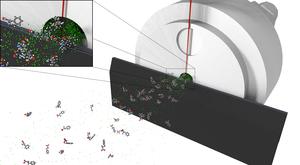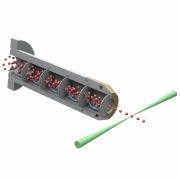Novel molecule sources
We are currently developing and implementing novel methodologies to vaporise large (bio)molecules and particles and efficiently inject them into vacuum for further manipulation.
We are interested in systems ranging in size from single isolated molecules, such as amino acids or DNA bases, all the way to large biological systems such as cells, protein complexes or viruses. A range of technologies is needed to cover this size range and ensure fragile biological samples remain intact during the injection.
Laser Desorption
We are currently designing a new laser desorption setup to introduce labile biological molecules into the gas-phase. In this technique molecules are mixed with a matrix material (e.g., graphite), which is then hit with a desoprtion laser. The matrix material will absorb the incoming laser energy and heat up, leading to the gentle ejection of target molecules from the matrix backbone. Our new experimental design will allow us to measure for extended time-periods and is fully translatable under vacuum, as required for measurements at Free-Electron lasers or synchrotron sources.
Laser Induced Acoustic Desorption (LIAD)
An even softer ionisation method than Laser Desorption, and applicable to even larger biological systems, is Laser Induced Acoustic Desorption. Here target molecules are introduced onto the front surface of a thin metallic foil, typically 10 micrometer thick Titanium. The foil is placed in vacuum and irradiated from the back by a pulsed UV laser. The laser pulse launches an acoustic (= shock) wave that travels trough the foil and "shakes off" molecules from the front surface. As there is no direct interaction between the laser and the target species, this is a very soft ionization method.
Aerodynamic lenses
For the vaporization of nano- and micrometer sized systems we are developing aerodynamic lens stacks that produced highly collimated and pure beams of these systems. Aerodynamic lenses employ a series of concentric appertures through which a light sheath-gas is flown. The produced flow field exerts drag forces on particles travelling through the lens and leads to a collimation of heavy particles on the axis, producing a collimated beam. Using detailed simulations we are developing a comprehensive understanding of aerodynamic lenses and the factors influencing the produced particle beams. Using this computational insight we are developing optimised lens stacks for our experiments.
Research Team
Lena Worbs, Jannik Lübke, Armando Estillore, Muhamed Amin, Amit Samanta, Jochen Küpper

